活性炭危险性评估报告(msds)
- 格式:docx
- 大小:37.26 KB
- 文档页数:5
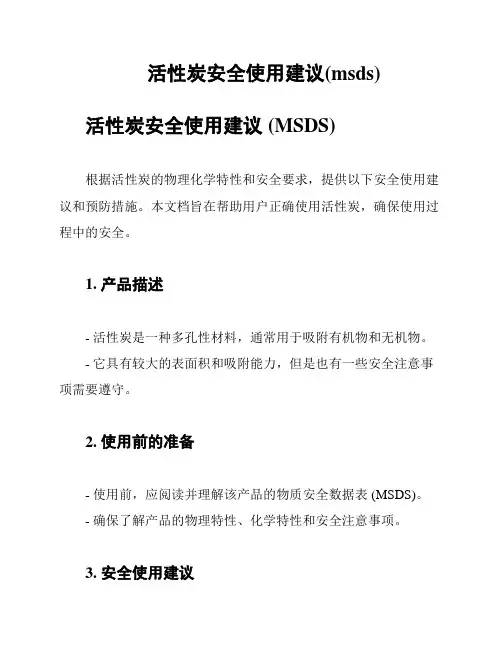
活性炭安全使用建议(msds)活性炭安全使用建议 (MSDS)根据活性炭的物理化学特性和安全要求,提供以下安全使用建议和预防措施。
本文档旨在帮助用户正确使用活性炭,确保使用过程中的安全。
1. 产品描述- 活性炭是一种多孔性材料,通常用于吸附有机物和无机物。
- 它具有较大的表面积和吸附能力,但是也有一些安全注意事项需要遵守。
2. 使用前的准备- 使用前,应阅读并理解该产品的物质安全数据表 (MSDS)。
- 确保了解产品的物理特性、化学特性和安全注意事项。
3. 安全使用建议- 在使用活性炭时,应佩戴适当的个人防护装备,如手套、安全眼镜和口罩。
- 避免直接接触皮肤、眼睛和呼吸道。
- 使用活性炭时要注意防火和爆炸的风险。
- 避免与可燃物质和氧化剂接触。
- 存储活性炭时,请保持通风良好的环境,并避免与酸性物质接触。
4. 废弃物处理- 活性炭在使用一段时间后会饱和,需要更换。
- 废弃的活性炭应正确处理,遵守当地法规和环保要求。
- 请参考当地的废弃物处理准则,避免环境污染和危害。
5. 紧急情况应急处理- 在紧急情况下,如误食、吸入或皮肤接触活性炭,请立即寻求医疗援助。
- 使用活性炭时,应使周围环境保持通风,并确保人员迅速撤离至安全区域。
- 在事故发生时,应立即通知当地应急机构,并提供相关安全信息。
6. 其他注意事项- 本建议仅适用于一般的活性炭使用情况。
- 不同类型的活性炭可能具有不同的物化特性和风险,请在具体使用前了解该产品的特性和安全要求。
以上是活性炭的安全使用建议,在使用过程中请务必遵守相关的安全规定和法规。
如有任何疑问或需要进一步的技术支持,请咨询相关专业人士或联系供应商。
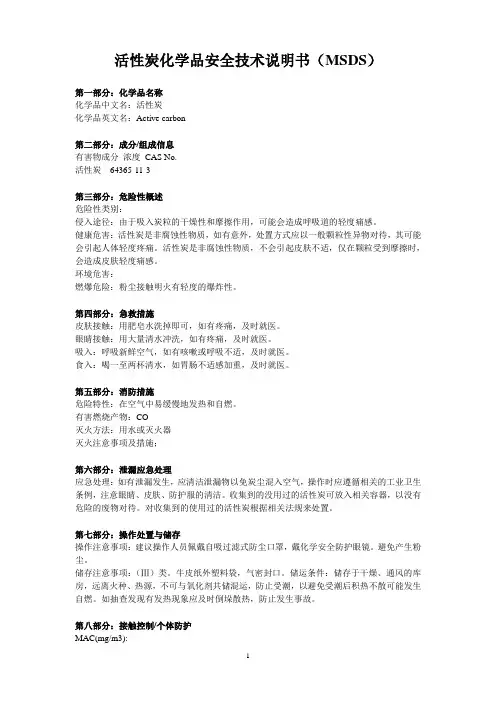
活性炭化学品安全技术说明书(MSDS)第一部分:化学品名称化学品中文名:活性炭化学品英文名:Active carbon第二部分:成分/组成信息有害物成分浓度CAS No.活性炭64365-11-3第三部分:危险性概述危险性类别:侵入途径:由于吸入炭粒的干燥性和摩擦作用,可能会造成呼吸道的轻度痛感。
健康危害:活性炭是非腐蚀性物质,如有意外,处置方式应以一般颗粒性异物对待,其可能会引起人体轻度疼痛。
活性炭是非腐蚀性物质,不会引起皮肤不适,仅在颗粒受到摩擦时,会造成皮肤轻度痛感。
环境危害:燃爆危险:粉尘接触明火有轻度的爆炸性。
第四部分:急救措施皮肤接触:用肥皂水洗掉即可,如有疼痛,及时就医。
眼睛接触:用大量清水冲洗,如有疼痛,及时就医。
吸入:呼吸新鲜空气,如有咳嗽或呼吸不适,及时就医。
食入:喝一至两杯清水,如胃肠不适感加重,及时就医。
第五部分:消防措施危险特性:在空气中易缓慢地发热和自燃。
有害燃烧产物:CO灭火方法:用水或灭火器灭火注意事项及措施;第六部分:泄漏应急处理应急处理:如有泄漏发生,应清洁泄漏物以免炭尘混入空气,操作时应遵循相关的工业卫生条例,注意眼睛、皮肤、防护服的清洁。
收集到的没用过的活性炭可放入相关容器,以没有危险的废物对待。
对收集到的使用过的活性炭根据相关法规来处置。
第七部分:操作处置与储存操作注意事项:建议操作人员佩戴自吸过滤式防尘口罩,戴化学安全防护眼镜。
避免产生粉尘。
储存注意事项:(Ⅲ)类。
牛皮纸外塑料袋,气密封口。
储运条件:储存于干燥、通风的库房,远离火种、热源,不可与氧化剂共储混运,防止受潮,以避免受潮后积热不散可能发生自燃。
如抽查发现有发热现象应及时倒垛散热,防止发生事故。
第八部分:接触控制/个体防护MAC(mg/m3):PC-TWA(mg/m3):PC-STEL(mg/m3):TLV-C(mg/m3):TLV-TWA(mg/m3):TLV-STEL(mg/m3):监测方法:工程控制:呼吸系统防护:建议使用矿山安全健康管理局要求的呼吸面具,咨询呼吸面具的制造商以便选定合适的面具。
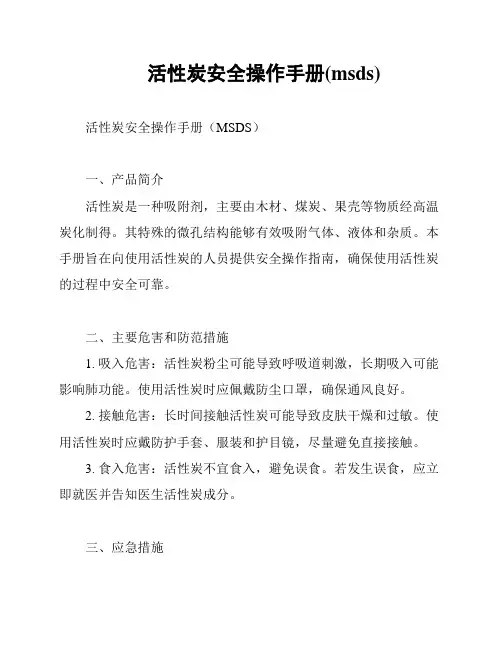
活性炭安全操作手册(msds)活性炭安全操作手册(MSDS)一、产品简介活性炭是一种吸附剂,主要由木材、煤炭、果壳等物质经高温炭化制得。
其特殊的微孔结构能够有效吸附气体、液体和杂质。
本手册旨在向使用活性炭的人员提供安全操作指南,确保使用活性炭的过程中安全可靠。
二、主要危害和防范措施1. 吸入危害:活性炭粉尘可能导致呼吸道刺激,长期吸入可能影响肺功能。
使用活性炭时应佩戴防尘口罩,确保通风良好。
2. 接触危害:长时间接触活性炭可能导致皮肤干燥和过敏。
使用活性炭时应戴防护手套、服装和护目镜,尽量避免直接接触。
3. 食入危害:活性炭不宜食入,避免误食。
若发生误食,应立即就医并告知医生活性炭成分。
三、应急措施1. 吸入:将受害人带到通风良好的地方,保持安静休息,如出现不适症状,立即就医。
2. 接触:立即用大量清水冲洗受影响部位,如有异常情况,就医检查。
3. 食入:立即就医,告知医生活性炭成分和食入量。
四、储存和处理1. 储存:活性炭应存放在清洁、阴凉、干燥的场所,远离火源和氧化剂。
2. 处理:在处理活性炭时,应采取防尘措施,使用防护手套和护眼设备,避免产生粉尘。
处理废弃活性炭时,应根据当地法规进行分类、包装和处理。
五、事故处置若发生活性炭泄露、火灾等事故情况,应立即采取措施进行扑灭和隔离,确保人员安全。
并通知相关部门和专业人员进行处理。
六、个人防护措施1. 呼吸系统防护:使用活性炭时应佩戴防尘口罩,确保通风良好。
2. 皮肤防护:长时间接触活性炭时应戴防护手套、服装,尽量避免直接接触。
3. 眼睛防护:使用活性炭时应戴护目镜,防止活性炭粉尘进入眼睛。
七、急救措施如出现吸入、接触或食入活性炭后的异常情况,应立即就医并告知医生有关情况和活性炭成分。
以上是活性炭安全操作手册(MSDS)的简要内容,详细信息请参阅正式版本的手册。
使用活性炭时请务必遵守相关安全指南,确保自身和他人的安全。
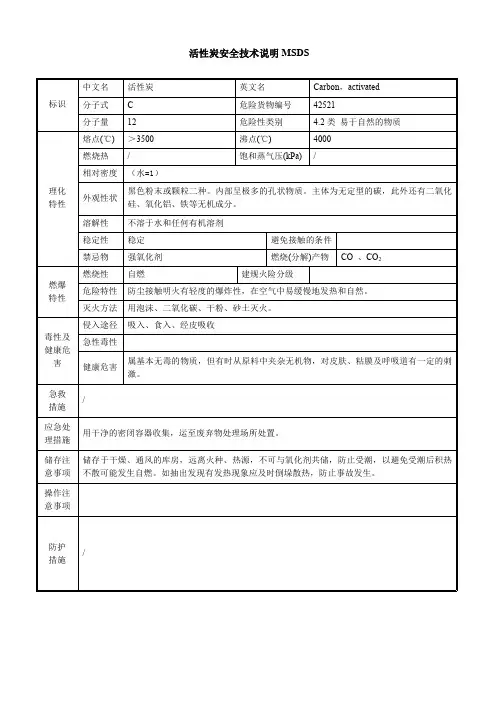
活性炭安全技术说明MSDS
标识中文名活性炭英文名Carbon,activated
分子式C危险货物编号42521
分子量12危险性类别 4.2类易于自然的物质
理化特性熔点(℃)>3500沸点(℃)4000
燃烧热/饱和蒸气压(kPa)/
相对密度(水=1)
外观性状
黑色粉末或颗粒二种。
内部呈极多的孔状物质。
主体为无定型的碳,此外还有二氧化
硅、氧化铝、铁等无机成分。
溶解性不溶于水和任何有机溶剂
稳定性稳定避免接触的条件
禁忌物强氧化剂燃烧(分解)产物CO、CO2
燃爆特性燃烧性自燃建规火险分级
危险特性防尘接触明火有轻度的爆炸性,在空气中易缓慢地发热和自然。
灭火方法用泡沫、二氧化碳、干粉、砂土灭火。
毒性及健康危害侵入途径吸入、食入、经皮吸收
急性毒性
健康危害
属基本无毒的物质,但有时从原料中夹杂无机物,对皮肤、粘膜及呼吸道有一定的刺
激。
急救
措施
/
应急处
理措施
用干净的密闭容器收集,运至废弃物处理场所处置。
储存注意事项储存于干燥、通风的库房,远离火种、热源,不可与氧化剂共储,防止受潮,以避免受潮后积热不散可能发生自燃。
如抽出发现有发热现象应及时倒垛散热,防止事故发生。
操作注
意事项
防护
措施
/。

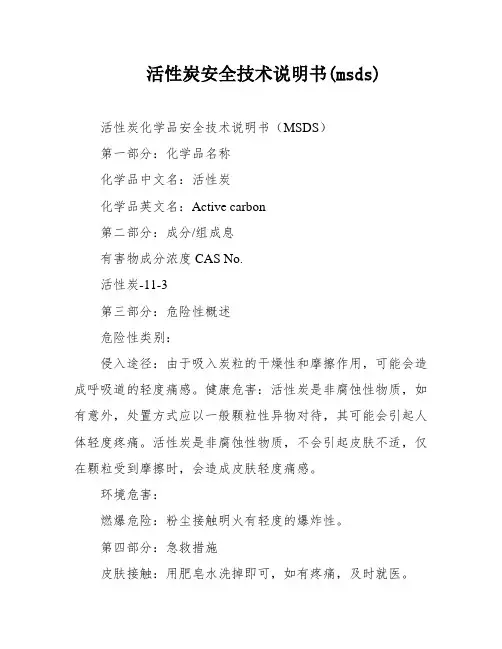
活性炭安全技术说明书(msds)活性炭化学品安全技术说明书(MSDS)第一部分:化学品名称化学品中文名:活性炭化学品英文名:Active carbon第二部分:成分/组成息有害物成分浓度CAS No.活性炭-11-3第三部分:危险性概述危险性类别:侵入途径:由于吸入炭粒的干燥性和摩擦作用,可能会造成呼吸道的轻度痛感。
健康危害:活性炭是非腐蚀性物质,如有意外,处置方式应以一般颗粒性异物对待,其可能会引起人体轻度疼痛。
活性炭是非腐蚀性物质,不会引起皮肤不适,仅在颗粒受到摩擦时,会造成皮肤轻度痛感。
环境危害:燃爆危险:粉尘接触明火有轻度的爆炸性。
第四部分:急救措施皮肤接触:用肥皂水洗掉即可,如有疼痛,及时就医。
眼睛接触:用大量清水冲洗,如有疼痛,及时就医。
吸入:呼吸新颖空气,如有咳嗽或呼吸不适,实时就医。
食入:喝一至两杯清水,如胃肠不适感加重,及时就医。
第五部分:消防步伐危险特性:在空气中易缓慢地发热和自燃。
有害燃烧产物:CO灭火方法:用水或灭火器灭火注意事项及措施;第六部分:泄漏应急处理应急处理:如有泄漏产生,应干净泄漏物以免炭尘混入空气,操作时应遵守相关的工业卫生条例,留意眼睛、皮肤、防护服的干净。
收集到的没用过的活性炭可放入相关容器,以没有风险的废物对待。
对收集到的使用过的活性炭按照相关法规来处置。
第七部分:操作处置与储存操作留意事项:建议操作职员佩戴自吸过滤式防尘口罩,戴化学安全防护眼镜。
制止产生粉尘。
储存注意事项:(Ⅲ)类。
牛皮纸外塑料袋,气密封口。
储运条件:储存于干燥、通风的库房,远离火种、热源,不可与氧化剂共储混运,防止受潮,以避免受潮后积热不散可能发生自燃。
如抽查发现有发热现象应及时倒垛散热,防止发生事故。
第八部分:接触控制/个体防护MAC(mg/m3):1PC-TWA(mg/m3):PC-STEL(mg/m3):TLV-C(mg/m3):TLV-TWA(mg/m3):TLV-STEL(mg/m3):监测方法:工程控制:呼吸系统防护:建议使用矿山安全健康管理局要求的呼吸面具,咨询呼吸面具的制造商以便选定合适的面具。
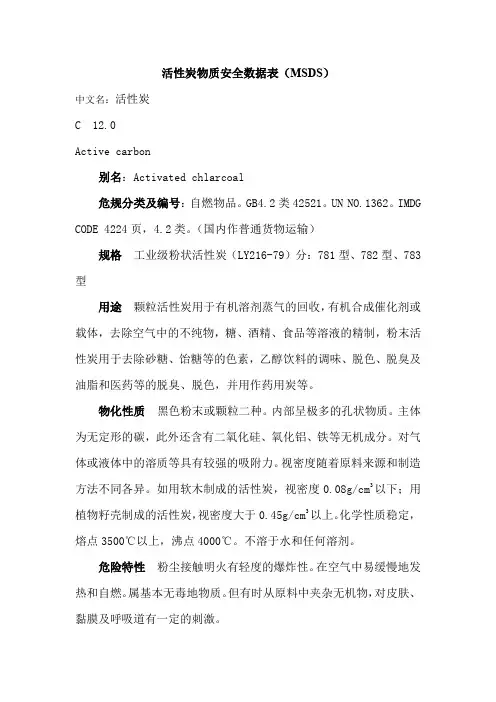
活性炭物质安全数据表(MSDS)中文名:活性炭C 12.0Active carbon别名:Activated chlarcoal危规分类及编号:自燃物品。
GB4.2类42521。
UN NO.1362。
IMDG CODE 4224页,4.2类。
(国内作普通货物运输)规格工业级粉状活性炭(LY216-79)分:781型、782型、783型用途颗粒活性炭用于有机溶剂蒸气的回收,有机合成催化剂或载体,去除空气中的不纯物,糖、酒精、食品等溶液的精制,粉末活性炭用于去除砂糖、饴糖等的色素,乙醇饮料的调味、脱色、脱臭及油脂和医药等的脱臭、脱色,并用作药用炭等。
物化性质黑色粉末或颗粒二种。
内部呈极多的孔状物质。
主体为无定形的碳,此外还含有二氧化硅、氧化铝、铁等无机成分。
对气体或液体中的溶质等具有较强的吸附力。
视密度随着原料来源和制造方法不同各异。
如用软木制成的活性炭,视密度0.08g/cm3以下;用植物籽壳制成的活性炭,视密度大于0.45g/cm3以上。
化学性质稳定,熔点3500℃以上,沸点4000℃。
不溶于水和任何溶剂。
危险特性粉尘接触明火有轻度的爆炸性。
在空气中易缓慢地发热和自燃。
属基本无毒地物质。
但有时从原料中夹杂无机物,对皮肤、黏膜及呼吸道有一定的刺激。
储运须知包装方法(Ⅲ)类。
牛皮纸外塑料袋,气密封口。
储运条件:储存于干燥、通风的库房,远离火种、热源,不可与氧化剂共储混运,防止受潮,以避免受潮后积热不散可能发生自燃。
如抽查发现有发热现象应及时倒垛散热,防止发生事故。
泄漏处理:扫起,倒至垃圾箱内。
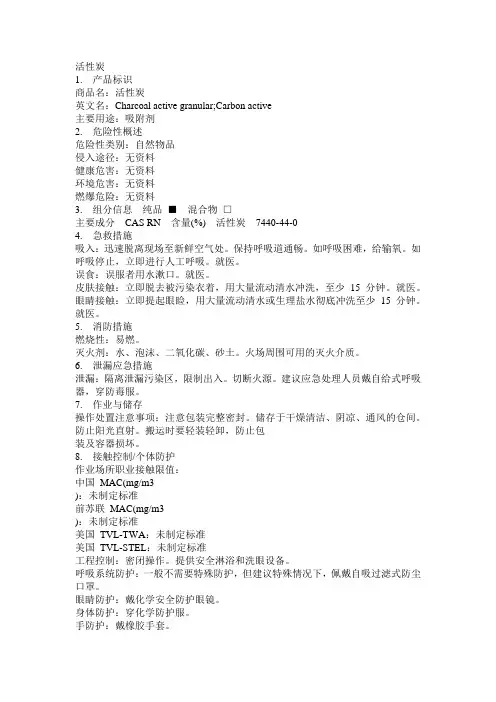
活性炭1. 产品标识商品名:活性炭英文名:Charcoal active granular;Carbon active主要用途:吸附剂2. 危险性概述危险性类别:自然物品侵入途径:无资料健康危害:无资料环境危害:无资料燃爆危险:无资料3. 组分信息纯品■混合物□主要成分CAS RN 含量(%) 活性炭7440-44-04. 急救措施吸入:迅速脱离现场至新鲜空气处。
保持呼吸道通畅。
如呼吸困难,给输氧。
如呼吸停止,立即进行人工呼吸。
就医。
误食:误服者用水漱口。
就医。
皮肤接触:立即脱去被污染衣着,用大量流动清水冲洗,至少15 分钟。
就医。
眼睛接触:立即提起眼睑,用大量流动清水或生理盐水彻底冲洗至少15 分钟。
就医。
5. 消防措施燃烧性:易燃。
灭火剂:水、泡沫、二氧化碳、砂土。
火场周围可用的灭火介质。
6. 泄漏应急措施泄漏:隔离泄漏污染区,限制出入。
切断火源。
建议应急处理人员戴自给式呼吸器,穿防毒服。
7. 作业与储存操作处置注意事项:注意包装完整密封。
储存于干燥清洁、阴凉、通风的仓间。
防止阳光直射。
搬运时要轻装轻卸,防止包装及容器损坏。
8. 接触控制/个体防护作业场所职业接触限值:中国MAC(mg/m3):未制定标准前苏联MAC(mg/m3):未制定标准美国TVL-TWA:未制定标准美国TVL-STEL:未制定标准工程控制:密闭操作。
提供安全淋浴和洗眼设备。
呼吸系统防护:一般不需要特殊防护,但建议特殊情况下,佩戴自吸过滤式防尘口罩。
眼睛防护:戴化学安全防护眼镜。
身体防护:穿化学防护服。
手防护:戴橡胶手套。
其他防护:工作现场严禁吸烟。
注意个人清洁卫生。
9. 理化特性外观与性状:黑色无定形颗粒或细微粉末,无臭、无味、无砂性。
溶解性:不溶于任何溶剂。
10. 稳定性和反应性稳定性:稳定聚合危害:聚合避免接触的条件:禁忌物:燃烧(分解)产物:二氧化碳。
11. 毒理学信息无资料12. 生态学信息无资料13. 废弃处置废弃方法:处置前应参阅国家和地方有关法规。
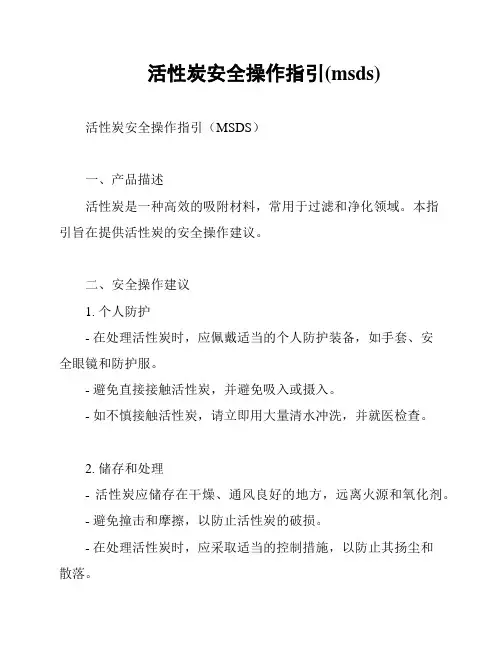
活性炭安全操作指引(msds)
活性炭安全操作指引(MSDS)
一、产品描述
活性炭是一种高效的吸附材料,常用于过滤和净化领域。
本指
引旨在提供活性炭的安全操作建议。
二、安全操作建议
1. 个人防护
- 在处理活性炭时,应佩戴适当的个人防护装备,如手套、安
全眼镜和防护服。
- 避免直接接触活性炭,并避免吸入或摄入。
- 如不慎接触活性炭,请立即用大量清水冲洗,并就医检查。
2. 储存和处理
- 活性炭应储存在干燥、通风良好的地方,远离火源和氧化剂。
- 避免撞击和摩擦,以防止活性炭的破损。
- 在处理活性炭时,应采取适当的控制措施,以防止其扬尘和
散落。
3. 废弃物处理
- 活性炭废弃物必须按当地法律法规进行处理。
- 不得随意倾倒或抛弃活性炭废弃物,以免对环境造成污染。
4. 急救措施
- 如不慎接触活性炭,请立即就医,并提供活性炭的物质安全数据表或本操作指引。
请注意:以上建议仅供参考,请在具体操作中遵循相关法律法规,并根据实际情况进行特定的安全措施和操作指导。
五、联系信息
如需进一步咨询或从事与活性炭相关的工作,可以联系以下部门:
- 名称:XX公司
- 地址:XX街道XX号
- 电话:XXX-XXXXXXX。
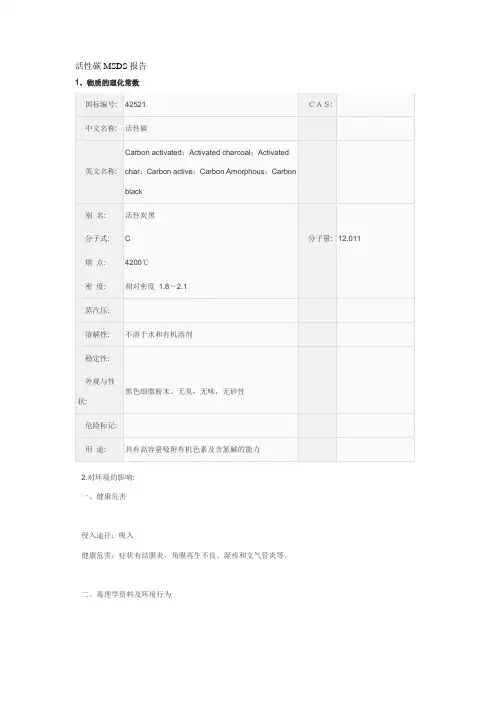
活性碳MSDS报告
1、物质的理化常数
国标编号: 42521 CAS: 中文名称: 活性碳
英文名称: Carbon activated;Activated charcoal;Activated char;Carbon active;Carbon Amorphous;Carbon black
别名: 活性炭黑
分子式: C 分子量: 12.011 熔点: 4200℃
密度: 相对密度 1.8~2.1
蒸汽压:
溶解性: 不溶于水和有机溶剂
稳定性:
外观与性
状:
黑色细微粉末。
无臭,无味,无砂性
危险标记:
用途: 具有高容量吸附有机色素及含氮碱的能力
2.对环境的影响:
一、健康危害
侵入途径:吸入
健康危害:症状有结膜炎,角膜再生不良、湿疹和支气管炎等。
二、毒理学资料及环境行为
危险特性:吸入粉尘有中等程度危险。
易燃。
3.现场应急监测方法:
4.实验室监测方法:
5.环境标准:
美国(1976)公共给水标准0.3mg/L
6.应急处理处置方法:
防护措施:操作时应戴防目镜,以避免眼反复接触。
工作者应每天淋浴。
急救措施:如进入眼中,迅速用水冲洗。
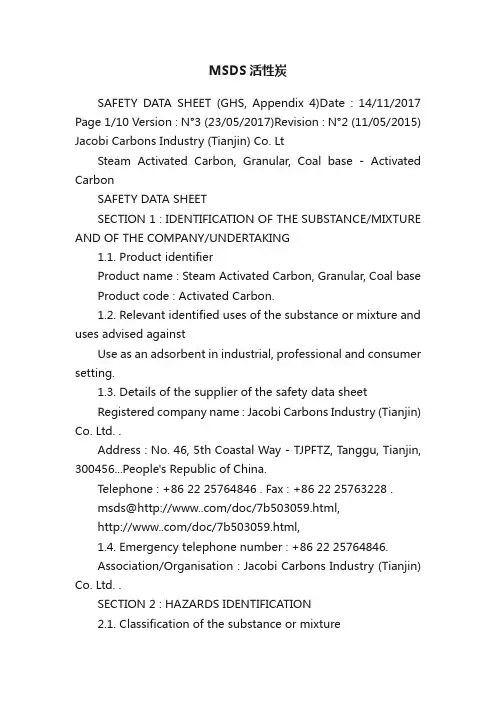
MSDS活性炭SAFETY DATA SHEET (GHS, Appendix 4)Date : 14/11/2017 Page 1/10 Version : N°3 (23/05/2017)Revision : N°2 (11/05/2015) Jacobi Carbons Industry (Tianjin) Co. LtSteam Activated Carbon, Granular, Coal base - Activated CarbonSAFETY DATA SHEETSECTION 1 : IDENTIFICATION OF THE SUBSTANCE/MIXTURE AND OF THE COMPANY/UNDERTAKING1.1. Product identifierProduct name : Steam Activated Carbon, Granular, Coal base Product code : Activated Carbon.1.2. Relevant identified uses of the substance or mixture and uses advised againstUse as an adsorbent in industrial, professional and consumer setting.1.3. Details of the supplier of the safety data sheetRegistered company name : Jacobi Carbons Industry (Tianjin) Co. Ltd. .Address : No. 46, 5th Coastal Way - TJPFTZ, Tanggu, Tianjin, 300456...People's Republic of China.Telephone : +86 22 25764846 . Fax : +86 22 25763228 .msds@/doc/7b503059.html,/doc/7b503059.html,1.4. Emergency telephone number : +86 22 25764846.Association/Organisation : Jacobi Carbons Industry (Tianjin) Co. Ltd. .SECTION 2 : HAZARDS IDENTIFICATION2.1. Classification of the substance or mixtureGHS compliant.This substance does not present a physical hazard. Refer to the recommendations regarding the other products present on the site.This substance does not present a health hazard with the exception of possible occupational exposure thresholds (see paragraphs 3 and8).This substance does not present an environmental hazard. No known or foreseeable environmental damage under standard conditions of use.2.2. Label elementsGHS compliant.No labelling requirements for this substance.2.3. Other hazardsIn the event of dust formed by mechanical action (sanding, sawing, etc..), this dust may cause irritation by inhalation and contact with eyes.May cause CO and CO2 emanations in the event of a fire.According to the ECHA Guidance on chemical safety assessment, Chapter R11, section R11.1.2.1: "The PBT and vPvB criteria of Annex XIII to the Regulation do not apply to inorganic substances". As Activated Carbon - HDS type is to be considered as an inorganic substance, the PBT assessment is not applicable.Wet Activated Carbon depletes oxygen from air and, therefore, dangerously low levels of oxygen may be encountered. Whenever workers enter a vessel containing activated carbon, the oxygen content should be determined and work procedures for potentially low oxygen areas should be followed.-M a d e u n d e r l i c e n c e o f E u r o p e a n L a b e l S y s t e m ?M S D S so f t w a r e f r o m I n f o D y n e -h t t p : / / w w w . i n f o d y n e . f r -SAFETY DATA SHEET (GHS, Appendix 4)Date : 14/11/2017 Page 2/10 Version : N°3 (23/05/2017)Revision : N°2 (11/05/2015) Jacobi Carbons Industry (Tianjin) Co. LtSteam Activated Carbon, Granular, Coal base - Activated CarbonSECTION 3 : COMPOSITION/INFORMATION ON INGREDIENTS3.1. SubstancesComposition :Identification GHS Note%CAS: 7440-44-0EC: 931-328-0REACH: 01-2119488894-16-0013ACTIVATED CARBON - HIGH DENSITYSKELETON (AC-HDS)[1]100%Information on ingredients :A porous, amorphous, high surface area adsorbent material composed largely of elemental carbon.[1] Substance for which maximum workplace exposure limits are available.SECTION 4 : FIRST AID MEASURESAs a general rule, in case of doubt or if symptoms persist, always call a doctor.NEVER induce swallowing by an unconscious person.4.1. Description of first aid measuresIn the event of exposure by inhalation :If breathing is irregular or has stopped, effect mouth-to-mouth resuscitation and call a doctor.Fresh air, rest.Obtain medical attention if cough or respiratory symptoms develop.In the event of splashes or contact with eyes :Wash thoroughly with fresh, clean water for 15 minutes holding the eyelids open.If there is any redness, pain or visual impairment, consult an ophthalmologist.In the event of splashes or contact with skin :Watch out for any remaining product between skin and clothing, watches, shoes, etc.Rince with water and soap.Remove contaminated clothes.Obtain medical attention if irritation becomes apparent.In the event of swallowing :Do not give the patient anything orally.In the event of swallowing, if the quantity is small (no more than one mouthful), rinse the mouth with water and consult a doctor. Seek medical attention immediately, showing the label.Give at least 1/2 L of water to drink.Obtain mediacl attention if gastrintestinal symptoms develop.Do not induce vomiting.4.2. Most important symptoms and effects, both acute and delayedWhen large amounts are ingested orally, congestion may occur.4.3. Indication of any immediate medical attention and special treatment neededSpecific and immediate treatment :N/A -M a d e u n d e r l i c e n c e o f E u r o p e a n L a b e l S y s t e m ?M S D S s o f t w a r e f r o m I n f o D y n e -h t t p : / / w w w . i n f o d y n e . f r -SAFETY DATA SHEET (GHS, Appendix 4)Date : 14/11/2017 Page 3/10 Version : N°3 (23/05/2017)Revision : N°2 (11/05/2015) Jacobi Carbons Industry (Tianjin) Co. LtSteam Activated Carbon, Granular, Coal base - Activated CarbonInformation for the doctor :Medications efficiency can be reduced by the adsorbing power of the activated carbon.SECTION 5 : FIREFIGHTING MEASURES5.1. Extinguishing mediaSuitable methods of extinctionIn the event of a fire, use :- sprayed water or water mist- carbon dioxide (CO2)- foam- powderUnsuitable methods of extinctionIn the event of a fire, do not use :- water jetin the closed areas, in order to avoid the water contamination.5.2. Special hazards arising from the substance or mixtureA fire will often produce a thick black smoke. Exposure to decomposition products may be hazardous to health.Do not breathe in smoke.In the event of a fire, the following may be formed :- carbon monoxide (CO)- carbon dioxide (CO2)- other decomposition products for the saturated activated carbon.After a fire, smoldering hotspots within the activated carbon may be present for a long time.Activated Carbon which has been allowed to smolder for a long time in a confined space may accumulate carbon monoxide above its lower explosion limit.5.3. Advice for firefightersDue to the toxicity of the gas emitted on thermal decomposition of the products, fire-fighting personnel are to be equipped with autonomous insulating breathing apparatus.SECTION 6 : ACCIDENTAL RELEASE MEASURES6.1. Personal precautions, protective equipment and emergency proceduresConsult the safety measures listed under headings 7 and 8.For first aid workerFirst aid workers will be equipped with suitable personal protective equipment (See section 8).6.2. Environmental precautionsPrevent any material from entering drains or waterways.6.3. Methods and material for containment and cleaning upRetrieve the product by mechanical means (sweeping/vacuuming).6.4. Reference to other sectionsSee also sections 2 & 8-M a d e u n d e r l i c e n c e o f E u r o p e a n L a b e l S y s t e m ?M S D S s o f t w a r e f r o m I n f o D y n e -h t t p : / / w w w . i n f o d y n e . f r -SAFETY DATA SHEET (GHS, Appendix 4)Date : 14/11/2017 Page 4/10 Version : N°3 (23/05/2017)Revision : N°2 (11/05/2015)Jacobi Carbons Industry (Tianjin) Co. LtSteam Activated Carbon, Granular, Coal base - Activated CarbonSECTION 7 : HANDLING AND STORAGERequirements relating to storage premises apply to all facilities where the substance is handled.7.1. Precautions for safe handlingAlways wash hands after handling.Prevent dust generation. Apply good working practices and engineering procedures during discharge.See the exposure controls and personal protection measures in the section 8.Fire prevention :Prevent access by unauthorised personnel.Prevent dust generation.Keep away from heat sources.Immediately retrieve the product in case of spillingRecommended equipment and procedures :For personal protection, see section 8.Observe precautions stated on label and also industrial safety regulations.Ensure containment and adequate ventilation.Whenever workers enter a vessel containing activated carbon, the oxygen content should be determined and work procedures for potentially low oxygen areas should be followed.Prohibited equipment and procedures :No smoking, eating or drinking in areas where the substance is used.7.2. Conditions for safe storage, including any incompatibilitiesKeep away from any chemical (solvents and strong oxidisers).Keep away from heat sources.Store in a well-ventilated area.Keep the container away from dampnessStorageStore and keep away from any chemical (solvents and strong oxidisers).Storage of wet activated carbon in a closed area can deplete oxygen from air.PackagingAlways keep in packaging made of an identical material to the original.Store in the closed, original packaging.7.3. Specific end use(s)No data available.SECTION 8 : EXPOSURE CONTROLS/PERSONAL PROTECTION8.1. Control parametersOccupational exposure limits :Non otherwise classified dusts : 10 mg/m3- UK / WEL (Workplace exposure limits, EH40/2005, 2007) : CAS TWA :STEL :Ceiling :Definition :Criteria : 7440-44-0 4 mg/m3Biological limits :/Derived no effect level (DNEL) or derived minimum effect level (DMEL): ACTIVATED CARBON - HIGH DENSITY SKELETON (AC-HDS) (CAS: 7440-44-0)-M a d e u n d e r l i c e n c e o f E u r o p e a n L a b e l S y s t e m ?M S D S s o f t w a r e f r o m I n f o D y n e -h t t p : / / w w w . i n f o d y n e . f r -SAFETY DATA SHEET (GHS, Appendix 4)Date : 14/11/2017Page 5/10 Version : N°3 (23/05/2017)Revision : N°2 (11/05/2015) Jacobi Carbons Industry (Tianjin) Co. LtSteam Activated Carbon, Granular, Coal base - Activated CarbonFinal use: Workers.Exposure method: Inhalation.Potential health effects: Short term local effects.DNEL : 3 mg of substance/m3Exposure method: Inhalation.Potential health effects: Long term systemic effects.DNEL : 3 mg of substance/m3Final use: Consumers.Exposure method: Inhalation.Potential health effects: Short term local effects.DNEL : 0.5 mg of substance/m3Exposure method: Inhalation.Potential health effects: Long term systemic effects.DNEL : 0.5 mg of substance/m38.2. Exposure controlsAppropriate engineering controlsLocal exhaust ventilation is recommended.For the use of Granular Activated Carbon, no risk management measures are mandatory, but only recommended.Personal protection measures, such as personal protective equipmentUse personal protective equipment that is clean and has been properly maintained.Store personal protective equipment in a clean place, away from the work area.Never eat, drink or smoke during use. Remove and washcontaminated clothing before re-using. Ensure that there is adequate ventilation, especially in confined areas.- Eye / face protectionAvoid contact with eyes.Before handling powders or dust emission, wear mask goggles in accordance with standard EN166.- Hand protectionWear suitable protective gloves in the event of prolonged or repeated skin contact.- Body protectionWork clothing worn by personnel shall be laundered regularly.After contact with the product, all parts of the body that have been soiled must be washed.- Respiratory protectionAvoid breathing dust.Type of FFP mask :Wear a disposable half-mask dust filter in accordance with standard EN149.Category :- FFP2Particle filter according to standard EN143 :- P (White)Exposure controls linked to environmental protectionLocal exhaust ventilation to remove material at source.Contained storage.Regulated waste disposal.-M a d e u n d e r l i c e n c e o f E u r o p e a n L a b e l S y s t e m ?M S D S s o f t w a r e f r o m I n f o D y n e -h t t p : / / w w w . i n f o d y n e . f r -SAFETY DATA SHEET (GHS, Appendix 4)Date : 14/11/2017Page 6/10 Version : N°3 (23/05/2017)Revision : N°2 (11/05/2015) Jacobi Carbons Industry (Tianjin) Co. LtSteam Activated Carbon, Granular, Coal base - Activated CarbonSECTION 9 : PHYSICAL AND CHEMICAL PROPERTIES9.1. Information on basic physical and chemical propertiesGeneral information :Physical state :Solid in granules.Color:BlackOdour:NoneImportant health, safety and environmental informationpH (aqueous solution) :7-11pH :Not relevant.Boiling point/boiling range :Not relevant.Flash point interval :Not relevant.Explosive properties, lower explosivity limit (%) :NCExplosive properties, upper explosivity limit (%) :NCVapour pressure (50°C) :Not relevant.Density :200-700 kg/m3Method for determining the density :ASTM D2854Water solubility :Insoluble. 0Method for determining the water solubility :OCDE Guideline 105 (Water solubility).Fat solubility :0Partition coefficient: n-octanol/water :NAMelting point/melting range :Not relevant.Self-ignition temperature :Not relevant.Decomposition point/decomposition range :Not relevant.9.2. Other informationPhysical and chemical properties of the saturated activated carbon may be different from the virgin material.SECTION 10 : STABILITY AND REACTIVITY10.1. ReactivityThis product shows no reactivity under the specified conditions of storage, shipment and use.10.2. Chemical stabilityThis substance is stable under the recommended handling and storage conditions in section 7.10.3. Possibility of hazardous reactionsIn contact with solvents and strong oxidisers.10.4. Conditions to avoidAvoid :- formation of dusts- heating- heat- humidityDusts can form an explosive mixture with air.10.5. Incompatible materialsKeep away from :- strong oxidising agents- combustible material -M a d e u n d e r l i c e n c e o f E u r o p e a n L a b e l S y s t e m ?M S D S s o f t w a r e f r o m I n f o D y n e -h t t p : / / w w w . i n f o d y n e . f r -SAFETY DATA SHEET (GHS, Appendix 4)Date : 14/11/2017 Page 7/10 Version : N°3 (23/05/2017)Revision : N°2 (11/05/2015) Jacobi Carbons Industry (Tianjin) Co. LtSteam Activated Carbon, Granular, Coal base - Activated Carbon- strong acids- solvents10.6. Hazardous decomposition productsThe thermal decomposition may release/form :- carbon monoxide (CO)- carbon dioxide (CO2)SECTION 11 : TOXICOLOGICAL INFORMATION11.1. Information on toxicological effectsIn the event of dust formed by mechanical action (sanding, sawing, etc..), this dust may cause irritation by inhalation and contact with eyes.11.1.1. SubstancesBased on the physical and chemical properties of activated carbons, the absence of effects on toxicological studies and the therapeutic use of activated carbons as adsorbing agents for the treatment of acute poisoning and acute diarrhoea, it can be expected that Activated Carbon is not absorbed via the oral, dermal and inhalation routes.Acute toxicity :ACTIVATED CARBON - HIGH DENSITY SKELETON (AC-HDS) (CAS: 7440-44-0)Oral route :LD50 > 2000 mg/kgSpecies : RatOECD Guideline 423 (Acute Oral toxicityAcute T oxic Class Method) Inhalation route (Dusts/mist) :LC50 > 64.4 mg/l Species : RatOECD Guideline 403 (Acute Inhalation Toxicity)Skin corrosion/skin irritation :ACTIVATED CARBON - HIGH DENSITY SKELETON (AC-HDS) (CAS: 7440-44-0)Corrosivity :No observed effect.Species : RabbitOECD Guideline 404 (Acute Dermal Irritation / Corrosion)Serious damage to eyes/eye irritation :ACTIVATED CARBON - HIGH DENSITY SKELETON (AC-HDS) (CAS: 7440-44-0)Corneal haze :Average score = 0.00Species : RabbitDuration of exposure : 72 hOECD Guideline 405 (Acute Eye Irritation / Corrosion) Iritis :Average score = 0.00Species : RabbitDuration of exposure : 72 hOECD Guideline 405 (Acute Eye Irritation / Corrosion) Conjunctival redness :Average score = 0.67Species : RabbitDuration of exposure : 72 hOECD Guideline 405 (Acute Eye Irritation / Corrosion) Conjunctival oedema :Average score = 0.33Species : RabbitDuration of exposure : 72 h -M a d e u n d e r l i c e n c e o f E u r o p e a n L a b e l S y s t e m ?M S D S s o f t w a r e f r o m I n f o D y n e -h t t p : / / w w w . i n f o d y n e . f r -SAFETY DATA SHEET (GHS, Appendix 4)Date : 14/11/2017 Page 8/10 Version : N°3 (23/05/2017)Revision : N°2 (11/05/2015) Jacobi Carbons Industry (Tianjin) Co. LtSteam Activated Carbon, Granular, Coal base - Activated CarbonOECD Guideline 405 (Acute Eye Irritation / Corrosion)Respiratory or skin sensitisation :- Skin Not sensitising.- Inhalation No information availableACTIVATED CARBON - HIGH DENSITY SKELETON (AC-HDS) (CAS: 7440-44-0)Local lymph node stimulation test :Non-Sensitiser.Species : MouseOECD Guideline 429 (Skin Sensitisation: Local Lymph Node Assay)Germ cell mutagenicity :All the key studies indicate that the substance does not show any genotoxic potential. Therefore, it can be concluded that the substance is not mutagenic and does not need to be classified for mutagenicity according to the criteria outlined in Annex I of 1272/2008/EC (CLP / EU GHS) and Annex VI of 67/548/EEC (DSD/DPD).ACTIVATED CARBON - HIGH DENSITY SKELETON (AC-HDS) (CAS: 7440-44-0)Mutagenesis (in vitro) :Negative.Species : BacteriaOECD Guideline 471 (Bacterial Reverse Mutation Assay)Ames test (in vitro) :Negative.With or without metabolic activation.Species : S. typhimurium TA1535Carcinogenicity :No data availableReproductive toxicant :No data availableSpecific target organ systemic toxicity - single exposure :ACTIVATED CARBON - HIGH DENSITY SKELETON (AC-HDS) (CAS: 7440-44-0)Oral route : C > 2000 mg/kg bodyweightSpecies : RatSECTION 12 : ECOLOGICAL INFORMATION12.1. Toxicity12.1.1. SubstancesAs Activated Carbon is insoluble in water, no toxicity is expected.12.2. Persistence and degradabilityActivated Carbon - HDS type is a refractory materail and not amenable to break down by any natural chemical or enzymatic processes.AC - HDS cannot be rendered into a soluble form capable of being absorbed.Therefore it cannot find its way to any cell site where it could be conceivably be biodegraded.12.3. Bioaccumulative potentialThe substance has a very low potential to bioaccumulate in aquatic species (e.g. fish), i.e. a BCF < 10.The substance has no log Kow, the substance size will impede passing membranes (particles with size > 0.5μm) and is not soluble in water. The bioaccumulation study is thus infeasible.12.4. Mobility in soilNo data available, as the substance is insoluble.-M a d e u n d e r l i c e n c e o f E u r o p e a n L a b e l S y s t e m ?M S D S s o f t w a r e f r o m I n f o D y n e -h t t p : / / w w w . i n f o d y n e . f r -SAFETY DATA SHEET (GHS, Appendix 4)Date : 14/11/2017 Page 9/10 Version : N°3 (23/05/2017)Revision : N°2 (11/05/2015) Jacobi Carbons Industry (Tianjin) Co. LtSteam Activated Carbon, Granular, Coal base - Activated Carbon12.5. Results of PBT and vPvB assessmentAccording to the ECHA Guidance on chemical safety assessment, Chapter R11, section R11.1.2.1: "The PBT and vPvB criteria of Annex XIII to the Regulation do not apply to inorganic substances". As Activated Carbon - HDS type is to be considered as an inorganic substance, the PBT assessment is not applicable.12.6. Other adverse effectsNo data available.SECTION 13 : DISPOSAL CONSIDERATIONSThe appropriate waste management of the substance and/or its container must be determined in accordance with local regulations.13.1. Waste treatment methodsDo not pour into drains or waterways.Waste :Waste management is carried out without endangering human health, without harming the environment and, in particular without risk to water, air, soil, plants or animals.Recycle or dispose of waste in compliance with current legislation, preferably via a certified collector or company.Do not contaminate the ground or water with waste, do not dispose of waste into the environment.Soiled packaging :Empty container completely. Keep label(s) on container.Give to a certified disposal contractor.SECTION 14 : TRANSPORT INFORMATIONTransport product in compliance with provisions of the ADR for road, RID for rail, IMDG for sea and ICAO/IATA for air transport (ADR 2015 - IMDG 2014 - ICAO/IATA 2016).14.1. UN number136214.2. UN proper shipping nameUN1362=CARBON, ACTIVATED14.3. Transport hazard class(es)- Classification :4.2- ExemptionADR/RID: special provision 646IMDG: special provision 925> Steam activated carbonIATA: special provision A3> Does not meet the defined criteria, after having been submitted to the 4.2 test (UN Manual of Tests and Criteria (§ 33.3.1.3.3)) US-DOT, 49CFR173.124: Does not meet the defined criteria, after having been submitted to the 4.2 test (UN Manual of Tests and Criteria (§ 33.3.1.3.3))14.4. Packing groupIII14.5. Environmental hazards-14.6. Special precautions for userADR/RID Class Code Pack /doc/7b503059.html,bel Ident.LQ Provis.EQ Cat.Tunnel4.2S2III 4.2400646E14EIMDG Class2°Label Pack gr.LQ EMS Provis.EQ4.2-III0F-A,S-J223 925E1IATA Class2°Label Pack gr.Passager Passager Cargo Cargo note EQ -M a d e u n d e r l i c e n c e o f E u r o p e a n L a b e l S y s t e m ?M S D S s o f t w a r e f r o m I n f o D y n e -h t t p :/ / w w w . i n f o d y n e . f r -SAFETY DATA SHEET (GHS, Appendix 4)Date : 14/11/2017 Page 10/10 Version : N°3 (23/05/2017)Revision : N°2 (11/05/2015) Jacobi Carbons Industry (Tianjin) Co. LtSteam Activated Carbon, Granular, Coal base - Activated Carbon4.2-III4720.5 kg4720.5 kg A3E14.2-III Forbidden Forbidden--A3E1For limited quantities, see part 2.7 of the OACI/IATA and chapter 3.4 of the ADR and IMDG.For excepted quantities, see part 2.6 of the OACI/IATA and chapter 3.5 of the ADR and IMDG.14.7. Transport in bulk according to Annex II of Marpol and the IBC CodeNo data available.SECTION 15 : REGULATORY INFORMATION15.1. Safety, health and environmental regulations/legislation specific for the substance or mixture The following regulations have been used:- Globally Harmonized System of Classification and Labelling of Chemicals (GHS), review no. 5 (2013)- Container information:No data available.- Particular provisions :No data available.- Standardised American system for the identification of hazards presented by the product in view ofemergency procedures (NFPA 704) :NFPA 704, Labelling: Health=0 Inflammability=1 Instability/Reactivity=1 Specific Risk=none10115.2. Chemical safety assessmentA chemical safety assessment according to the rules stipulated in REACH directive has been performed. The appendices provide anoverview of the risk management measures as based on this assessment.SECTION 16 : OTHER INFORMATIONSince the user's working conditions are not known by us, the information supplied on this safety data sheet is based on our current level of knowledge and on national and community regulations.It is at all times the responsibility of the user to take all necessary measures to comply with legal requirements and local regulations.The information in this safety data sheet must be regarded as a description of the safety requirements relating to the substance and not as a guarantee of the properties thereof.Abbreviations :DNEL : Derived No-Effect LevelADR : European agreement concerning the international carriage of dangerous goods by Road.IMDG : International Maritime Dangerous Goods.IATA : International Air Transport Association.ICAO : International Civil Aviation OrganisationRID : Regulations concerning the International carriage of Dangerous goods by rail.-M a d e u n d e r l i c e n c e o f E u r o p e a n L a b e l S y s t e m ?M S D S s o f t w a r e f r o m I n f o D y n e -h t t p : / / w w w . i n f o d y n e . f r -。
活性炭安全技术说明书m s d sThis model paper was revised by the Standardization Office on December 10, 2020活性炭化学品安全技术说明书(MSDS)第一部分:化学品名称化学品中文名:活性炭化学品英文名:Active carbon第二部分:成分/组成信息有害物成分浓度 CAS No.活性炭 64365-11-3第三部分:危险性概述危险性类别:侵入途径:由于吸入炭粒的干燥性和摩擦作用,可能会造成呼吸道的轻度痛感。
健康危害:活性炭是非腐蚀性物质,如有意外,处置方式应以一般颗粒性异物对待,其可能会引起人体轻度疼痛。
活性炭是非腐蚀性物质,不会引起皮肤不适,仅在颗粒受到摩擦时,会造成皮肤轻度痛感。
环境危害:燃爆危险:粉尘接触明火有轻度的爆炸性。
第四部分:急救措施皮肤接触:用肥皂水洗掉即可,如有疼痛,及时就医。
眼睛接触:用大量清水冲洗,如有疼痛,及时就医。
吸入:呼吸新鲜空气,如有咳嗽或呼吸不适,及时就医。
食入:喝一至两杯清水,如胃肠不适感加重,及时就医。
第五部分:消防措施危险特性:在空气中易缓慢地发热和自燃。
有害燃烧产物:CO灭火方法:用水或灭火器灭火注意事项及措施;第六部分:泄漏应急处理应急处理:如有泄漏发生,应清洁泄漏物以免炭尘混入空气,操作时应遵循相关的工业卫生条例,注意眼睛、皮肤、防护服的清洁。
收集到的没用过的活性炭可放入相关容器,以没有危险的废物对待。
对收集到的使用过的活性炭根据相关法规来处置。
第七部分:操作处置与储存操作注意事项:建议操作人员佩戴自吸过滤式防尘口罩,戴化学安全防护眼镜。
避免产生粉尘。
储存注意事项:(Ⅲ)类。
牛皮纸外塑料袋,气密封口。
储运条件:储存于干燥、通风的库房,远离火种、热源,不可与氧化剂共储混运,防止受潮,以避免受潮后积热不散可能发生自燃。
如抽查发现有发热现象应及时倒垛散热,防止发生事故。
第八部分:接触控制/个体防护MAC(mg/m3):PC-TWA(mg/m3):PC-STEL(mg/m3):TLV-C(mg/m3):TLV-TWA(mg/m3):TLV-STEL(mg/m3):监测方法:工程控制:呼吸系统防护:建议使用矿山安全健康管理局要求的呼吸面具,咨询呼吸面具的制造商以便选定合适的面具。
活性炭安全储存要求(msds)活性炭安全储存要求(MSDS)1. 简介活性炭是一种具有高度多孔结构的吸附剂,常用于去除水和气体中的污染物。
为了确保活性炭的安全储存和使用,本文档提供了一些重要的要求。
2. 安全储存要求- 包装和标记包装和标记- 活性炭应储存在密封的中,以防止湿气和其他污染物的侵入。
- 需要在上明确标记活性炭的种类、批次和生产日期等信息。
- 储存环境储存环境- 活性炭应储存于通风良好的室内环境,远离高温和火源。
- 避免与化学物品、酸性物质或易燃物质接触。
- 防潮措施防潮措施- 活性炭对水分敏感,因此储存环境应保持干燥。
- 建议使用防潮剂或在储存区域安装湿度控制设备。
- 避光避光- 活性炭应避免长时间暴露在阳光直射下,以防止质量受损。
3. 急救措施- 眼部接触眼部接触- 若活性炭进入眼睛,应立即用大量清水冲洗至少15分钟,并寻求医疗帮助。
- 皮肤接触皮肤接触- 若活性炭接触皮肤,应立即用肥皂和温水彻底清洗,并保持清洁。
- 口服口服- 若不慎吞食活性炭,应给予足量清水漱口,并尽快就医。
- 吸入吸入- 若吸入大量活性炭,应迅速脱离现场,保持呼吸道通畅,并立即就医。
4. 废弃物处理活性炭属于特殊废弃物,需要按照当地法规进行处理。
请咨询相关部门以获取正确的废弃物处理方法。
5. 引用请在引用活性炭安全储存要求时,务必确认信息的真实性并标明出处。
以上是关于活性炭安全储存要求的简要说明,希望对您有帮助。
如有进一步问题或需要详细信息,请随时与我们联系。
*注意:本文档仅供参考。
具体的活性炭安全储存要求可能因不同情况而有所不同。
在实际操作中,请遵循适用的法律法规和生产工艺要求。
*。
活性炭化学品安全技术说明书(MSDS)第一部分:化学品名称化学品中文名:活性炭化学品英文名:Active carbon第二部分:成分/组成信息有害物成分浓度CAS No.活性炭64365-11-3第三部分:危险性概述危险性类别:侵入途径:由于吸入炭粒的干燥性和摩擦作用,可能会造成呼吸道的轻度痛感。
健康危害:活性炭是非腐蚀性物质,如有意外,处置方式应以一般颗粒性异物对待,其可能会引起人体轻度疼痛。
活性炭是非腐蚀性物质,不会引起皮肤不适,仅在颗粒受到摩擦时,会造成皮肤轻度痛感。
环境危害:燃爆危险:粉尘接触明火有轻度的爆炸性。
第四部分:急救措施皮肤接触:用肥皂水洗掉即可,如有疼痛,及时就医。
眼睛接触:用大量清水冲洗,如有疼痛,及时就医。
吸入:呼吸新鲜空气,如有咳嗽或呼吸不适,及时就医。
食入:喝一至两杯清水,如胃肠不适感加重,及时就医。
第五部分:消防措施危险特性:在空气中易缓慢地发热和自燃。
有害燃烧产物:CO灭火方法:用水或灭火器灭火注意事项及措施;第六部分:泄漏应急处理应急处理:如有泄漏发生,应清洁泄漏物以免炭尘混入空气,操作时应遵循相关的工业卫生条例,注意眼睛、皮肤、防护服的清洁。
收集到的没用过的活性炭可放入相关容器,以没有危险的废物对待。
对收集到的使用过的活性炭根据相关法规来处置。
第七部分:操作处置与储存操作注意事项:建议操作人员佩戴自吸过滤式防尘口罩,戴化学安全防护眼镜。
避免产生粉尘。
储存注意事项:(Ⅲ)类。
牛皮纸外塑料袋,气密封口。
储运条件:储存于干燥、通风的库房,远离火种、热源,不可与氧化剂共储混运,防止受潮,以避免受潮后积热不散可能发生自燃。
如抽查发现有发热现象应及时倒垛散热,防止发生事故。
第八部分:接触控制/个体防护MAC(mg/m3):PC-TWA(mg/m3):PC-STEL(mg/m3):TLV-C(mg/m3):TLV-TWA(mg/m3):TLV-STEL(mg/m3):监测方法:工程控制:呼吸系统防护:建议使用矿山安全健康管理局要求的呼吸面具,咨询呼吸面具的制造商以便选定合适的面具。
活性炭安全技术说明书
一、成分/组成信息:
化学品名称:活性炭分子式:C 英文名称:Carbon activated 有害成分含量 CAS NO C
二、危险性概述:
健康危害:症状有结膜炎,角膜再生不良、湿疹和支气管炎等。
燃爆危险:易燃。
三、急救措施:
皮肤接触:脱去污染的衣着,用大量流动清水冲洗。
眼睛接触:立即提起眼睑,用大量流动清水或生理盐水彻底冲洗至少15分钟;就医。
吸入:迅速脱离现场至空气新鲜处,保持呼吸道通畅,如呼吸困难,给输氧,如呼吸停止,立即进行人工呼吸;就医。
食入:用水漱口,给饮牛奶或蛋清,就医。
四、消防措施:
危险特性:吸入粉尘有中等程度危险,易燃。
燃烧(分解)产物:二氧化碳。
灭火方法:用水、砂土等扑救。
五、接触控制/个体防护:
呼吸系统防护:可能接触其粉尘时,必须佩过滤式防尘口罩。
眼睛防护:戴防护眼镜。
身体防护:穿工作服。
手防护:戴手套。
其它防护:工作场所禁止吸烟、进食和饮水,饭前要洗手,工作完毕,淋浴更衣,注意个人清洁卫生。
六、理化特性:
外观与性状:黑色细微粉末。
无臭,无味,无砂性
分子量 12.011 蒸汽压
沸点 4200℃溶解性不溶于水和有机溶剂
密度相对密度 1.8~2.1 稳定性
七、废弃处置:
废弃处置方法:处置前应参阅国家和地方有关法规。
活性炭危险性评估报告(msds)活性炭危险性评估报告(MSDS)
报告编号。
[填写报告编号]报告编号。
[填写报告编号]报告编号。
[填写报告编号]报告编号。
[填写报告编号]
报告日期。
[填写报告日期]报告日期。
[填写报告日期]报告日期。
[填写报告日期]报告日期。
[填写报告日期]
1.危险性概述
活性炭是一种常用的吸附剂,可用于去除水和空气中的杂质。
尽管它在正常使用条件下通常是安全的,但在某些情况下可能产生一些危险。
1.1 火灾危险性
活性炭在高温下可能会发生自燃,产生火灾。
避免将活性炭暴露于明火或高温源。
1.2 健康危害
长时间暴露于活性炭粉尘中可能导致呼吸道刺激和可能的肺部
损害。
建议在处理活性炭时使用适当的防护措施,如戴口罩和手套。
1.3 环境危害
大量的活性炭可能对水环境造成污染。
在处理废弃的活性炭时,请遵循相应的环境保护法规,确保正确处置。
2.应急措施
2.1 火灾
- 如果发生活性炭火灾,请立即采取灭火措施,如使用干粉灭
火器或二氧化碳灭火器。
- 避免用水灭火,以免扩散火势和产生有毒气体。
2.2 眼部接触
- 如发生活性炭粉尘进入眼睛,请立即用清水冲洗眼睛,持续至少15分钟。
如眼部不适持续,请寻求医疗帮助。
2.3 皮肤接触
- 如活性炭接触皮肤,请立即用温水和肥皂彻底清洗受影响部位。
- 如发生皮肤红肿、痒或其他异常,请咨询医务人员。
3.操作安全
3.1 适当的使用
- 活性炭应仅用于其规定的用途,并按照提供的操作指南进行使用。
- 遵守所有相关安全和操作规程,确保在安全的工作环境中使用活性炭。
3.2 适当的存储
- 将活性炭存放在干燥、通风良好的地方。
- 避免将活性炭暴露于阳光直射或高温环境。
3.3 废弃物处理
- 废弃的活性炭应根据当地环境保护法规进行处理。
- 建议将废弃的活性炭交由专业的废物处理公司处理,以确保环境安全。
4.急救措施
4.1 呼吸系统
- 如误吸入大量活性炭粉尘,请转移到空气清新处,并尽早寻求医疗帮助。
4.2 眼部接触
- 如活性炭粉尘进入眼中,请立即用清水冲洗,持续至少15分钟,并寻求医疗帮助。
4.3 皮肤接触
- 如发生大面积皮肤接触,请立即用大量温水和肥皂清洗,并告知医务人员使用活性炭。
---
以上报告仅供参考,请在使用前仔细阅读有关产品的详细安全说明。